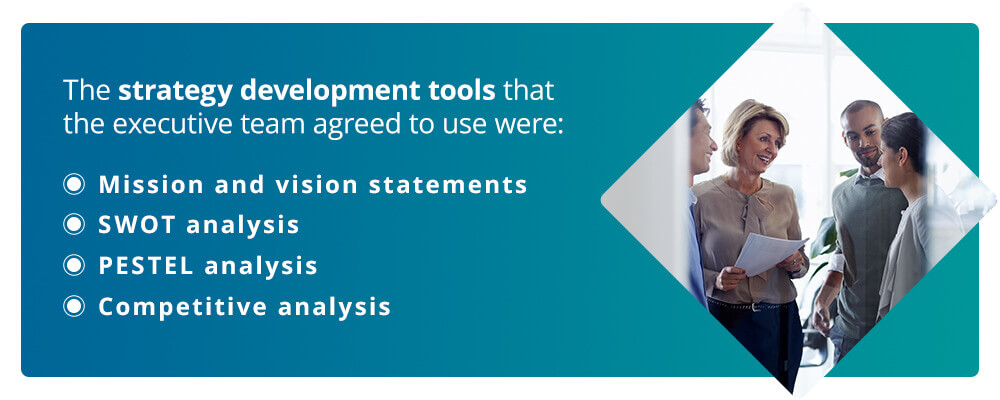In this strategic plan example, we review the structure of a strategic plan for a hotel chain and include elements of the plan itself. New England Hospitality Company, a fictitious company that owns and operates 37 hotels, is embarking on its first strategic plan and will be used for this strategic plan example. To help identify the primary areas of strategic focus – and to gain consensus among its management team – the organization agreed to focus its strategy using specific tools and to also use a five-level hierarchy of strategic themes, goals, objectives, strategies, and tactics.
Strategic Plan Example: Strategy Development Tools

The strategy development tools that the executive team agreed to use were:
- Mission and vision statements
- SWOT analysis
- PESTEL analysis
- Competitive analysis
The mission statement defines the purpose of a company and why it exists, while a vision statement focuses on what the organization hopes to achieve. For in-depth information on mission and mission, download our white papers, Mission Statements: A How-To and The Strategic Importance of Vision Statements. To provide a firm foundation for planning, New England Hospitality developed the following mission and visions statements:
- Mission: To create family memories.
- Vision: To be the No.1 family-oriented hotel chain in New England.
The SWOT analysis, which is an acronym for Strengths, Weaknesses, Opportunities, and Threats. By analyzing these four criteria, New England Hospitality was able to gain a better understanding of how it interfaces with the marketplace. For more information on SWOTs, check out our tutorial, What is a SWOT Analysis? New England Hospitality also conducted a PESTEL analysis, which stands for Political factors, Economic factors, Social factors, Technological factors, Environmental factors, and Legal/Regulatory factors. In this strategic plan example, the PESTEL Analysis helped company executives deliberate on external factors that could present external opportunities or threats.
Finally, New England Hospitality conducted a competitive analysis, to determine how the hotel chain stacked up against competitors in the hotel industry. This analysis helped New England Hospitality explore a way to create a unique position in the marketplace.
Strategic Plan Example: The 5-Level Hierarchy
In this strategic plan example, New England Hospitality opted for a five-level plan, which consisted of the following:
- Strategic Themes: These are one- to three-word affinity group headings used to compartmentalize strategic and operational plans. New England Hospitality’s selected Quality, People, Service, and Finance and its strategic themes.
- Goals: These are broad statements that translate the organization’s vision statement into something more meaningful and time-bound. For New England Hospitality’s Service strategic theme, the executive team this goals statement: “To be No. 1 in customer satisfaction of all hotel chains in New England.
- Objectives: These are quantifiable and measurable targets, that answer the questions of how much, by when. Objectives include baseline performance, targeted performance, and an established date for achieving the date. In this strategic plan example, the objectives for New England Hospitality’s service goal were two-fold: 1) Increase customer satisfaction from 82.6% to 87.5% by December 31, and 2) Increase percent of customers who have a repeat stay within six months of initial stay from 38.1% to 48.4% by December 31.
- Strategies: These are the broad action-oriented items that we implement to achieve the objectives.
- Tactics: These are the individual action items that comprise the strategies. They include an due date, deliverable, and are assigned to specific people in the organization for execution.
Strategic Plan Example: New England Hospitality Strategic Plan

- Mission: To create family memories.
- Vision: To be the No.1 family-oriented hotel chain in New England.
- Strategic Themes:
- 1. Quality
- 2. People
- 3. Service
- Goal 3: To be No. 1 in customer satisfaction of all hotel chains in New England.
- Objective 3.1: Increase customer satisfaction from 82.6% to 87.5% by December 31
- Strategy 3.1.1: Implement guest welcome program
- Tactic 3.1.1.1: Identify components of program
- Tactic 3.1.1.2: Test program components and make revisions
- Tactics 3.1.1.3: Create collateral material for guest welcome program
- Tactic 3.1.1.3: Develop staff training for guest welcome program
- Tactic 3.1.1.4: Go live with guest training program
- Strategy 3.1.2: Implement pre-arrival concierge program
- Tactic 3.1.3.1: Create procedures for concierge program
- Tactic 3.1.2.2: Develop guest activity menu
- Tactic 3.1.2.3: Provide training to concierges
- Tactic 3.1.2.4: Develop follow-up customer satisfaction survey
- Tactics 3.1.2.5: Go live with pre-arrival concierge program
- Strategy 3.1.1: Implement guest welcome program
- Objective 3.2: Increase percent of customers who have a repeat stay within six months of initial stay from 38.1% to 48.4% by December 31.
- Strategy 3.1.1: Implement frequent stay affinity program
- Tactic 3.1.1.1: Develop frequent stay affinity program rules and benefits
- Tactic 3.1.1.2: Procure software to track and manage frequent stay affinity program
- Tactic 3.1.1.3: Create collateral material for frequent stay affinity program
- Tactic 3.1.1.4: Provide training for all staff
- Tactics 3.1.1.5: Go live with frequent stay affinity program
- Strategy 3.1.1: Implement frequent stay affinity program
- Objective 3.1: Increase customer satisfaction from 82.6% to 87.5% by December 31
Strategic Plan Example: Additional Components

New England Hospitality, the focus of this strategic plan example, augmented its plan with a balanced scorecard, key performance indicators, dashboards, and scorecards. With all components in place, the company was prepared to drive accountability, elevate execution, and accelerate the results curve – all of which combine to create a classic strategic plan example.
About AchieveIt
AchieveIt is the platform that large organizations use to get their biggest, most important initiatives out of the boardroom and into reality. Too many great ideas never quite make it across the finish line, because there’s no real way to keep everyone on course and keep everything on track. What does it take to actually guide these initiatives all the way through to completion? You’ve got to:
- Get everything in view – so you can see what’s happening with every initiative, at every level, from the enterprise to the individual, in real-time.
- Get everyone engaged – with an easy-to-use platform that connects your organization from the executive leadership to the project teams, keeping everyone accountable and on the same page.
- Get every possible advantage – not only because you have the premier platform in this space, but because you can draw on the experience and best practices of our execution experts.
That’s why everyone from global corporations, to regional healthcare systems, to federal agencies have turned to AchieveIt for their Integrated Plan Management. Let’s actually do this.



